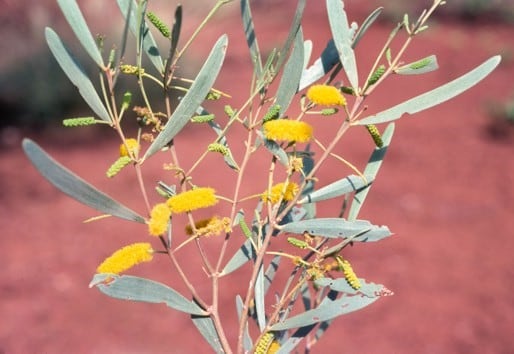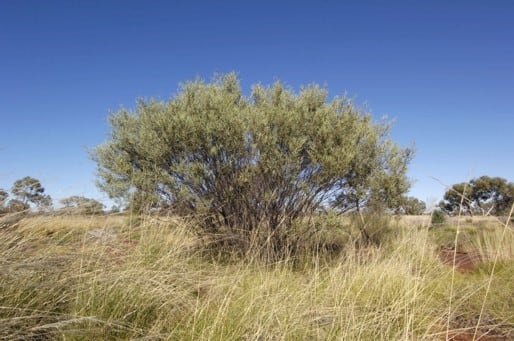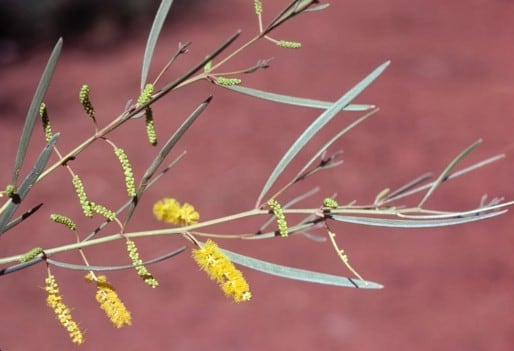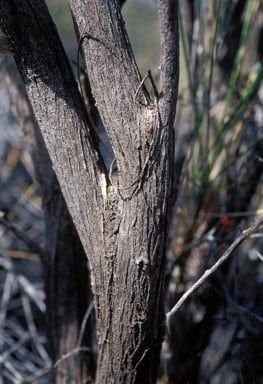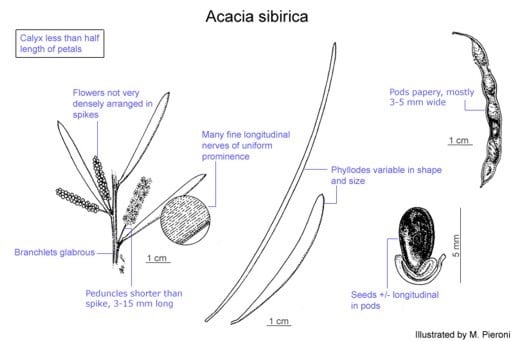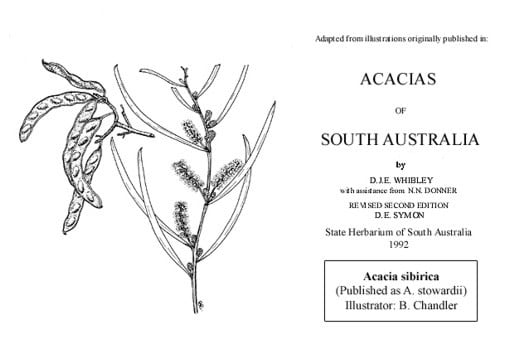Acacia sibirica S.Moore
WATTLE
Acacias of Australia
Common Name
False Witchetty Bush, Desert Witchetty Bush, Bastard Mulga
Family
Fabaceae
Distribution
Occurs in all mainland States except Vic.
Description
Bushy, multi-stemmed shrub or tree 1.5–5 (–6) m high, resprouts from the base and also from seed following fire. Bark fissured at base, grey. Branchlets terete except at resinous apices, glabrous. Phyllodes variable in shape and size, linear to narrowly oblong or narrowly elliptic, flat, rarely terete to subterete (especially in Qld), straight to shallowly or moderately incurved, (2–) 3.5–10 (–13) cm long, 1–5 (–7) mm wide, l:w = 8–60 (–100), acute to subacute, somewhat coriaceous, ±rigid, glabrous, finely multistriate with the nonanastomosing nerves of uniform prominence and 9–15 per mm; gland ±basal. Peduncles 3–15 mm long, shorter than spikes; spikes paired in upper axils, obloid or cylindrical, 0.3–1 (–3.5) cm long, light golden, the flowers not especially densely arranged. Flowers 5-merous; calyx cupular, dissected to 1/5 its length, ¼–1/3 length of corolla. Pods narrowly oblong to linear, straight-sided or variably ±constricted between seeds, flat, convex over seeds alternately on each side, to 12.5 cm long, 3–5 (–8) mm wide, chartaceous, brown, glabrous. Seeds longitudinal to longitudinally oblique, elliptic-oblong, 3–5 mm long, dark brown to blackish; areole small, with U-shaped pleurogram.
Phenology
Appears to flower throughout the year; fruits mainly Aug.–Dec. and occasionally at other times of the year.
Habitat
Common in shallow soils of stony or rocky ridges and breakaways, also on sand dunes; often in mulga communities on low hills.
Specimens
W.A.: Goongarrie, B.R.Maslin 1948 (K, L, NSW, PERTH). N.T.: southern boundary, Indiana Stn, N.M.Henry 926 (BRI, NSW, PERTH). S.A.: Stuart Creek Stn, 12 km NW of Blower Waterhole, F.J.Badman 3763 (AD, CANB, CORD, NE, NY). Qld: 5 miles [8 km] N of Toompine on Quilpie–Thargomindah road, Warrego district, I.V.Newman 923 (CANB, NSW). N.S.W.: Tibooburra, 25 Oct. 1949, E.F.Constable s.n. (A, AD, K, MEL, NSW, TL, Z).
Notes
The name A. sibirica was treated as synonymous with A. kempeana by P.G.Kodela, Fl. Australia 11B: 293; this name is now considered the correct name for the taxon treated as A. stowardii by NSW, Fl. Australia 11B: 295–296 (2001).
Plants of A. sibirica from the Pilbara region in W.A. are extremely variable, especially with respect to phyllode dimensions which are often longer and/or broader than on plants elsewhere. The complex patterns of variation require further study. The phyllodes vary from long, narrow and linear (generally 5–10 cm x 1–2 mm with l:w = 25–60) to short, broad (generally 3.5–7 cm x 3–5 mm with l:w = 8–15) and narrowly oblong to narrowly elliptic; there appears to be no sharp distinction between these two forms. The linear phyllode form was called A. stowardii Variant 1 in Fl. Australia 11B: 296 (2001) and the more widespread, shorter phyllode form was called A. stowardii Variant 2 in the same place. See B.R.Maslin, Nuytsia 4: 98–99 (1982) for further discussion of this variation.
Acacia sibirica is very similar to A. kempeana and their relationship requires further study. It is similarly closely related to A. duriuscula; A. thoma is more distantly related. Broad phyllode forms of A. sibirica are often very difficult to distinguish from A. rhodophloia in the absence of knowing bark characters (bark red ‘Minni Ritchi’ in A. rhodophloia); these species putatively hybridize in the Pilbara (see A. rhodophloia × sibirica). Plants of A. sibirica with long, narrow phyllodes superficially resemble A. adsurgens which is distinguished by having generally longer phyllodes with a slight but discernibly pronounced central nerve, generally paler yellow spikes with flowers more densely arranged, a longer calyx relative to the corolla and peduncles which are about as long as the spikes.
FOA Reference
Data derived from Flora of Australia Volumes 11A (2001), 11B (2001) and 12 (1998), products of ABRS, ©Commonwealth of Australia
Author
Revised by B.R.Maslin
Dr M.D.Tindale and Dr P.G.Kodela with the assistance of M.Bedward, S.J.Davies, C.Herscovitch, D.A.Keith and/or D.A.Morrison
This identification key and fact sheets are available as a mobile application:
URL: https://apps.lucidcentral.org/wattle/
© Copyright 2018. All rights reserved.
